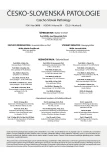Celiac disease-like enteropathy due to antihypertensive therapy with the angiotensin-II receptor type 1 inhibitor eprosartan
Authors:
Hans Maier 1; Karlheinz Hehemann 2; Michael Vieth 1
Authors‘ workplace:
Institute of Pathology, Klinikum Bayreuth, Germany
1; Practice of Internal Medicine, Beckum-Neubeckum, Germany
2
Published in:
Čes.-slov. Patol., 51, 2015, No. 2, p. 87-88
Category:
Original Article
Overview
An 83-year-old woman with hypertension received the angiotensin-II receptor type 1 blocker (ARB) eprosartan for more than 10 years. Six months ago, the dosage of the drug was doubled, and the patient reported a sudden onset of diarrhea. Duodenal biopsies showed a celiac disease-like pathology with flattened mucosa and an increase of intraepithelial lymphocytes and eosinophils, but serology of celiac disease remained negative. Celiac disease-like changes have been previously reported to be associated with other ARBs. This is the first case following eprosartan medication. In celiac-disease-like pathology of the small bowel with negative serology, drug-induced changes, for example due to ARBs, should be excluded.
Keywords:
celiac disease – negative serology – ARB – eprosartan
Duodenal changes caused by drugs mimicking the classical pathology of coeliac disease are a well-known pitfall in pathology. They have been recently described in patients treated with olmesartan, a newer member of angiotensin-II receptor type 1 inhibitors (ARBs) with a prolonged degradation time and higher effect on hypertension. It has been documented in one study on 22 patients (1) and two case reports (2,3). We report here similar changes during therapy with eprosartan, another drug of the ARB family.
CLINICAL HISTORY AND METHODS
An 83-year-old woman reported a sudden onset of diarrhea. A gastroscopy was performed, and biopsies from the duodenum were taken. After fixation with 4% buffered formaldehyde and embedding in paraffin, slices of 5 µm thickness were stained with hematoxylin/eosin (H&E). Histology revealed a severe attenuation of the duodenal villi (Fig. 1). The amount of intraepithelial lymphocytes was over 25/100 epithelial cells, accompanied by eosinophilic granulocytes (Fig. 2). Subepithelial collagen deposits were not noticed. No cells with expression of IgG4 were present.


The serology for celiac disease was negative in our patient. Our inquiry of more detailed information on the clinical history and on the possible use of medications disclosed a long-standing history of systemic hypertension and an antihypertensive therapy with eprosartan for the last ten years. Six months ago, the daily dosage of 300 mg (half of a tablet) had been doubled to 600mg, apparently causing the gastrointestinal symptoms. There was no history of celiac disease in previous biopsies. After our diagnosis of eprosartan-induced diarrhea and concomitant mucosal changes of the small bowel, eprosartan was replaced through an application of the calcium channel blocker amlodipin with cessation of diarrhea. Control biopsies three and six months after the diagnosis showed only slightly improved mucosal architecture, indicating a delayed regeneration of the duodenal mucosa after application of ARBs like eprosartan.
DISCUSSION
Eprosartan belongs to the first generation of ARBs recommended for the therapy of hypertension, chronic heart failure, and for protection from diabetic nephropathy and myocardial infarction. When applied per os, 90% of the drug is eliminated unchanged by feces, as a mirror of a poor oral bioavailability (4). About 10% is taken up rapidly from the gastrointestinal tract (4). It has been shown that the oral clearance of eprosartan is decreasing parallel to age, and that disturbances in renal and hepatic function may negatively influence the pharmacokinetics of eprosartan (4). In addition to celiac-disease-like pathology caused by olmesartan, our case is the first one reporting similar side effects using eprosartan.
Duodenal histology showing shortening or complete flattening of the villi combined with raised content of intraepithelial lymphocytes leads to a panel of differential diagnosis. The diagnosis of celiac disease itself needs clinical confirmation by serological testing which had been negative in our patient. Autoimmune duodenopathy is characterized by a significant infiltration by IgG4 positive cells but they were not found in the duodenal biopsies of our case. Non-steroidal antirheumatic drugs (NSAR) might also mimic celiac disease-like pathology and should be excluded by the patient´s medical history. Another cause for severe mucosal flattening and cell infiltration in young persons might be Crohn´s disease. This presumptive diagnosis affords confirmation by bioptic examination of the ileum and colorectum.
In conclusion, in cases with sudden onset of a celiac-like pathology with negative serology, several differential diagnoses should be ruled out. The possibility of drug-induced changes, esp. such caused by ARB or NSAR medication, has to be excluded by inquiring for information on the patient´s medication.
CONFLICT OF INTEREST
The authors declare that there is no conflict of interests regarding the publication of this paper.
Correspondence address:
Hans Maier M.D.
Institute of Pathology, Klinikum Bayreuth,
Preuschwitzer Strasse 101, D-95445 Bayreuth, Germany
tel.: +49 921 400 5602, fax: +49 921 400 5609
e-mail: hans.maier@klinikum-bayreuth.de
Sources
1. Rubio-Tapia A, Herman ML, Ludvigsson JF, et al. Severe spruelike enteropathy associated with olmesartan. Mayo Clin Proc 2012; 87(8): 732-738.
2. Dreifuss SE, Tomizawa Y, Farber NJ, Davison JM, Sohnen AE. Spruelike enteropathy associated with olmesartan: An unusual case of severe diarrhea. Case Rep Gastrointest Med 2013; 2013 : 618071.
3. Nielsen JA, Steephen A, Lewin M. Angiotensin-II inhibitor (olmesartan)-induced collagenous sprue with resolution following discontinuation of drug. World J Gastroenterolog 2013; 19(40): 6928-6930.
4. Michel MC, Foster C, Brunner HR, Liu L. A systematic comparison of the properties of clinically used angiotensin II type 1 receptor antagonists. Pharmacol Rev 2013; 65(2): 809-848.
Labels
Anatomical pathology Forensic medical examiner ToxicologyArticle was published in
Czecho-Slovak Pathology

2015 Issue 2
Most read in this issue
- Practical comments on examination of placenta in the second and third trimester of gravidity
- Molecular pathology of endometrial carcinoma – a review
- EGFR in triple negative breast carcinoma: significance of protein expression and high gene copy number
- Unusual lung finding of massive alveolar filling with foamy macrophages in congenital epidermolysis bullosa after amnion fluid aspiration in 15-day-old newborn without any clinical signs of respiratory impairment
